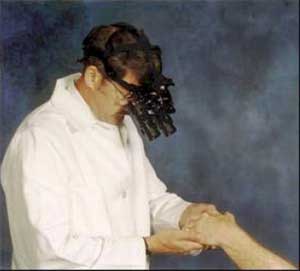Researchers at the US Air Force Research Laboratory's Materials and Manufacturing Directorate have developed a device that can be used to locate veins and arteries in wounded soldiers on the battlefield.
The "Vein Viewer," said Robert Crane, a senior materials scientist who helped lead the directorate's research effort, shortens the time it takes to help soldiers wounded in combat - a factor that could save many lives during that "golden five minutes" when a soldier's life may be in peril.
‘According to military medical personnel, the most pressing need on the battlefield is the ability to insert an intravenous (IV) needle into a wounded soldier to administer life-sustaining fluids after a serious wound occurs,’ Crane said.
A critical problem is that prompt insertion of an IV can be difficult to impossible under low ambient lighting or night-time conditions. ‘Conventional methods for finding a patient's veins have had to rely on feeling and visual cues - a guess and stab process,’ he added.
Crane, Byron Edmonds, Walter Johnson and Charles Lovett, and other scientists and engineers in the directorate, successfully addressed this problem using night vision goggles (NVGs) equipped with specially designed light filters developed by the air force for quite different purposes.
‘The goggles enable the wearer to see infrared light passing through the patient's body, except where it's partially blocked by blood moving through the veins and arteries. This happens because the infrared light is absorbed by the blood. The result is attendant medical personnel can see the arteries and veins, and gain rapid access to them if needed, and with much less physical discomfort to the patient,’ Crane explained.
The new technology solves some urgent challenges for the medical community. The Vein Viewer, for example, works with patients with darker complexions who tend to be less translucent. Additionally, it works with heavier patients, whose veins and arteries are deeper under the skin and more difficult to access.

‘After the initial discovery of this new infrared technology, we quickly realised that we could also see arteries, bones, tendons and other tissues, so the term “Vein Viewer,” the name chosen early on for the technology, doesn't really tell you what it is capable of,’ Crane explained.
A patent has been granted and a license has been issued in hopes that the technology will be commercialised. ‘Right now, there are so many possible applications, the medical research community will be working on them for some time,’ Crane pointed out.
A prototype of the Vein Viewer has been successfully demonstrated at Wright-Patterson Medical Center, Cincinnati Children's Hospital Medical Center, and Columbus Children's Hospital. ‘Many physicians have commented that this technology would alleviate a great deal of suffering by patients, especially small infants, who must sometimes undergo painful medical procedures requiring access to veins, such as drawing blood and IV insertions,’ Crane said.




Nanogenerator consumes CO2 to generate electricity
Nice to see my my views being backed up by no less a figure than Sabine Hossenfelder https://youtu.be/QoJzs4fA4fo